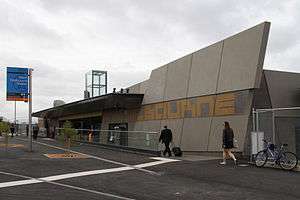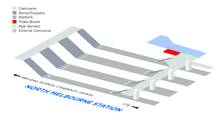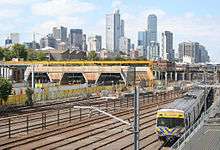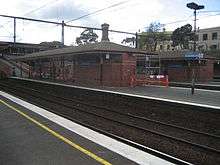North Melbourne railway station
North Melbourne railway station is located on the northern edge of the central business district of Melbourne, Australia. The station is a major interchange point with the Craigieburn, Flemington Racecourse, Sunbury, Upfield, Werribee and Williamstown lines all servicing the station. It opened on 6 October 1859,[2][3] and is listed on the Victorian Heritage Register.[4]
North Melbourne | ||||||||||||||||||||||||||||||||||||||||||
|---|---|---|---|---|---|---|---|---|---|---|---|---|---|---|---|---|---|---|---|---|---|---|---|---|---|---|---|---|---|---|---|---|---|---|---|---|---|---|---|---|---|---|
| Commuter and regional rail station | ||||||||||||||||||||||||||||||||||||||||||
 Station front in November 2009 | ||||||||||||||||||||||||||||||||||||||||||
| Location | Railway Place, West Melbourne, Victoria Australia | |||||||||||||||||||||||||||||||||||||||||
| Coordinates | 37°48′23″S 144°56′28″E | |||||||||||||||||||||||||||||||||||||||||
| Owned by | VicTrack | |||||||||||||||||||||||||||||||||||||||||
| Operated by | Metro Trains Melbourne | |||||||||||||||||||||||||||||||||||||||||
| Line(s) | Craigieburn Flemington Racecourse (special events only) Sunbury Upfield Werribee Williamstown (weekdays only) | |||||||||||||||||||||||||||||||||||||||||
| Distance | 1.68 kilometres from Southern Cross | |||||||||||||||||||||||||||||||||||||||||
| Platforms | 6 (2 side, 2 island) | |||||||||||||||||||||||||||||||||||||||||
| Tracks | 6 | |||||||||||||||||||||||||||||||||||||||||
| Construction | ||||||||||||||||||||||||||||||||||||||||||
| Structure type | Ground | |||||||||||||||||||||||||||||||||||||||||
| Disabled access | Yes | |||||||||||||||||||||||||||||||||||||||||
| Other information | ||||||||||||||||||||||||||||||||||||||||||
| Status | Premium station | |||||||||||||||||||||||||||||||||||||||||
| Station code | NME | |||||||||||||||||||||||||||||||||||||||||
| Fare zone | 1 | |||||||||||||||||||||||||||||||||||||||||
| Website | Public Transport Victoria | |||||||||||||||||||||||||||||||||||||||||
| History | ||||||||||||||||||||||||||||||||||||||||||
| Opened | 6 October 1859 | |||||||||||||||||||||||||||||||||||||||||
| Electrified | Yes | |||||||||||||||||||||||||||||||||||||||||
| Traffic | ||||||||||||||||||||||||||||||||||||||||||
| Passengers (2008-2009) | 0.686 million[1] | |||||||||||||||||||||||||||||||||||||||||
| Passengers (2009-2010) | 0.845 million[1] | |||||||||||||||||||||||||||||||||||||||||
| Passengers (2010-2011) | 1.091 million[1] | |||||||||||||||||||||||||||||||||||||||||
| Passengers (2011-2012) | 1.258 million[1] | |||||||||||||||||||||||||||||||||||||||||
| Passengers (2012-2013) | Not measured[1] | |||||||||||||||||||||||||||||||||||||||||
| Passengers (2013-2014) | 1.479 million[1] | |||||||||||||||||||||||||||||||||||||||||
| Services | ||||||||||||||||||||||||||||||||||||||||||
| ||||||||||||||||||||||||||||||||||||||||||
Station overview
Facilities

Located in West Melbourne, the main station entrance is at the south end of the platforms at the intersection of Adderley and Dryburgh Streets. This building contains the main booking office, public toilets and a kiosk, with platform access via escalators and lifts. From the north end brick ramps links the platforms, and platforms 2 through 6 have heritage listed verandas and brick waiting rooms.
At the north end of the station are 1970s era brown brick buildings built over the former Dynon Road overpass, which contains public toilets and a former railway parcels office. Until November 2009 this building also housed the main exit to Ireland Street and Railway Place, along with the booking office and kiosk, until they were moved to the current concourse at the south end. The north end also has exit leading west to the Melbourne Yard rail freight terminal, which is not open to public access.[5]
History


The first railway through the site of North Melbourne station was today's Williamstown line and the first section of the Melbourne, Mount Alexander and Murray River Railway Company line (to Sunbury), both opened on 13 January 1859. The first passenger station with two platforms was opened on 6 December 1859, and the present six platform station was opened on 9 June 1886.[6]
The new station was of free classical architecture, with red brick was used with cream brick banding, along with verandas and cast iron lace work.[4] As built in 1886 North Melbourne had six platforms, with four platform buildings containing ladies toilets and a ladies waiting room. The main booking office, waiting room, and station master's office was located near the ramp to platform 1, and men's toilets and porters' offices were located under the ramps themselves.[4]
The suburban train stabling yard near the station was opened in December 1973 as part of the City Loop project.[7] The footbridge that links the sidings with the Macaulay maintenance centre also opened around this time.[8] The washing plant and additional sidings in Melbourne Yard were made operational in May 1995, as part of the Jolimont Yard rationalisation.[9]
The station buildings on the northern concourse were constructed in 1974,[4] and in the 1980s as part of the construction works for the City Loop the ramps to Platforms 1 and 2 were altered, and the platform extended north.
It was upgraded to a Premium station on 19 July 1996.[10]
In May 2006, it was announced that the station was to be redeveloped as part of a $36 million project.[11] Work included a new main entrance at the southern end of the station with escalators, stairs and lifts installed for quicker access to other platforms and to help disabled passengers. Work started in May 2007 and was completed on 16 November 2009.[12][13] To aid construction and avoid disruption to train passengers a crash deck was erected over the tracks, to permit trains to continue running normally underneath while building work continued overhead.[3]
In March 2008 Sita Buslines' route 401 started operating from North Melbourne station to the Royal Melbourne Hospital and University of Melbourne in Carlton and Parkville, enabling commuters to avoid travelling via the City Loop.[14][15]
From December 2013, V/Line Geelong and Warrnambool services no longer stopped at the station, due to the opening of the first section of the Regional Rail Link between Southern Cross and South Kensington, which by-passed North Melbourne.[16] On 11 July 2014, Ballarat, Ararat, Bendigo, Swan Hill and Echuca line services also ceased stopping at North Melbourne, having been switched to the Regional Rail Link tracks[17]
In November 2017, the state government announced that as part of the Metro Tunnel project, North Melbourne would be renamed West Melbourne, to better reflect its geographical location, and to allow a nearby new station to be named North Melbourne.[18] The name change plan was later abandoned.[19]
Platforms & services
North Melbourne has six platforms. It is serviced by Metro Trains' Craigieburn, Sunbury, Upfield, Werribee and Williamstown services[20][21][22][23][24] and V/Line Seymour and Shepparton services.[25][26][27]
Platform 1:
- Craigieburn line all stations services to Flinders Street
- Upfield line all stations services to Flinders Street
- Flemington Racecourse line services to Southern Cross (special event days only)
- Seymour line V/Line services to Southern Cross (set down only)
- Shepparton line V/Line services to Southern Cross (set down only)
Platform 2:
- Craigieburn line all stations services to Craigieburn
- Upfield line all stations services to Upfield
- Flemington Racecourse line express services to Showgrounds and/or Flemington Racecourse (special event days only)
- Seymour line V/Line services to Seymour (pick up only)
- Shepparton line V/Line services to Shepparton (pick up only)
Platform 3:
- Sunbury line all stations services to Flinders Street
- Werribee line weekend all stations services to Flinders Street
- Seymour line V/Line services to Southern Cross (set down only)
Platform 4:
- Sunbury line all stations and limited stop services to Watergardens & Sunbury
Platform 5:
- Craigieburn line all stations services to Flinders Street
- Werribee line weekday all stations services to Flinders Street
- Williamstown line weekday all stations services to Flinders Street
- Flemington Racecourse line all stations services to Flinders Street (special event days only)
Platform 6:
- Craigieburn line all stations services to Craigieburn
- Werribee line all stations and limited stops services to Laverton & Werribee
- Williamstown line weekday all stations and limited stops services to Williamstown
- Flemington Racecourse line express services to Showgrounds and/or Flemington Racecourse (special event days only)
Transport links
Sita Buslines operates one route to and from North Melbourne station:
- 401: to University of Melbourne[28]
References
- "Train Station Patronage FY2008-2014". Public Transport Victoria. 14 May 2015. Archived from the original (XLS) on 30 March 2016. Retrieved 1 November 2016. (access from Archived 3 November 2016 at the Wayback Machine)
- North Melbourne Vicsig
- North Melbourne Station Rail Geelong
- "North Melbourne Railway Station Complex (listing VICH1582)". Australia Heritage Places Inventory. Department of Sustainability, Environment, Water, Population and Communities. Retrieved 21 May 2008.
- Connex Melbourne (16 October 2009). "News: North Melbourne Station – Closure of footbridge". www.connexmelbourne.com.au. Retrieved 16 November 2009.
- Turton, Keith W (1973). Six And A Half Inches From Destiny. The first hundred years of the Melbourne-Wodonga Railway 1873-1973. Australian Railway Historical Society. p. 86. ISBN 0-85849-012-9.
- SE Dornan & RG Henderson (1979). Electric Railways of Victoria. Australian Electric Traction Society. p. 93. ISBN 0-909459-06-1.
- "Way & Works". Newsrail. Australian Railway Historical Society. February 1974. p. 43.
- Daryl Dedman (October 1998). "Farewell to Melbourne Yard". Newsrail. www.series567railvideo.com.au. Archived from the original on 4 January 2006. Retrieved 11 August 2008.
- "Upgrading Eltham to a Premium Station". Newsrail. Australian Railway Heritage Society. October 1997. p. 310.
- "Station to get $36m revamp - Herald Sun". www.news.com.au. 15 May 2006. Retrieved 21 May 2008.
- "Public transport - Metropolitan railway station projects". www.doi.vic.gov.au. Archived from the original on 7 October 2006. Retrieved 21 May 2008.
- Concrete Concepts Archived 13 April 2014 at the Wayback Machine Cement Concrete & Aggregates Australia
- "Media Release: New Shuttle Service Provides Vital Link for Commuters". www.dpc.vic.gov.au. 3 March 2008. Archived from the original on 20 July 2008. Retrieved 21 May 2008.
- North Melbourne Shuttle Service a Hit with Commuters Archived 13 April 2014 at the Wayback Machine Minister for Public Transport 13 March 2008
- Changes to Geelong line services from Sunday 22 December 2013 Archived 13 April 2014 at the Wayback Machine Public Transport Victoria
- Major Regional Rail Link signalling works planned for June and July Premier of Victoria 13 June 2014
- Lillebuen, Steve; Jacks, Timna (29 November 2017). "Metro Tunnel: New train station names revealed". The Age. Retrieved 29 November 2017.
- New North Melbourne Metro Tunnel station renamed due to emergency fears Herald Sun 25 January 2020
- "Craigieburn Line". Public Transport Victoria.
- "Sunbury Line". Public Transport Victoria.
- "Upfield Line". Public Transport Victoria.
- "Werribee Line". Public Transport Victoria.
- "Williamstown Line". Public Transport Victoria.
- Seymour - Melbourne timetable Public Transport Victoria
- Bendigo - Melbourne timetable Public Transport Victoria
- Shepparton - Melbourne timetable Public Transport Victoria
- "401 North Melbourne Station - Melbourne University Loop via Royal Melbourne Hospital". Public Transport Victoria.
External links

- Melway map at street-directory.com.au